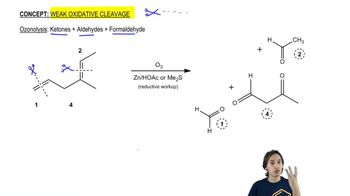Here are the essential concepts you must grasp in order to answer the question correctly.
Ozonolysis
Ozonolysis is a reaction involving the cleavage of alkenes or alkynes using ozone (O3) to form carbonyl compounds, such as aldehydes and ketones. The process typically occurs in two steps: first, the alkene reacts with ozone to form a molozonide, which rearranges to form ozonide. The ozonide is then reduced, often using reagents like zinc and acetic acid or dimethyl sulfide, to yield the final carbonyl products.
Recommended video:
General properties of ozonolysis.
Reagents for Ozonolysis
The reagents commonly used in ozonolysis include ozone (O3) for the initial reaction and a reducing agent such as zinc (Zn) in acetic acid or dimethyl sulfide (DMS) for the second step. These reagents facilitate the conversion of the ozonide intermediate into stable carbonyl compounds, allowing for the identification and synthesis of specific products from the original alkene.
Recommended video:
General properties of ozonolysis.
Mechanism of Ozonolysis
The mechanism of ozonolysis involves the electrophilic attack of ozone on the double bond of an alkene, leading to the formation of a cyclic molozonide. This intermediate undergoes rearrangement to form a more stable ozonide, which is then cleaved by the reducing agent to yield carbonyl compounds. Understanding this mechanism is crucial for predicting the products of ozonolysis and for designing synthetic pathways in organic chemistry.
Recommended video:
General properties of ozonolysis.

 Verified step by step guidance
Verified step by step guidance Verified video answer for a similar problem:
Verified video answer for a similar problem:



 6:30m
6:30m